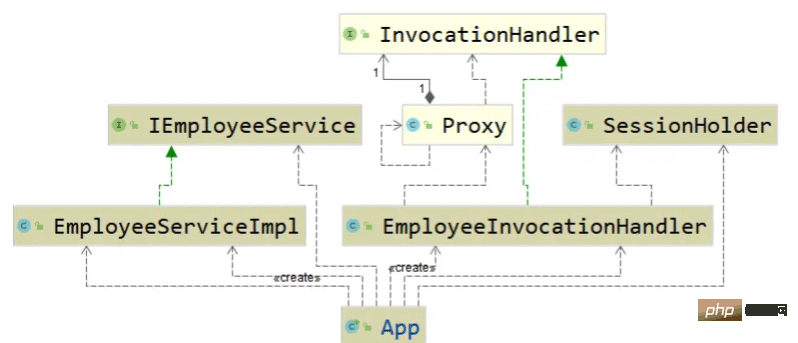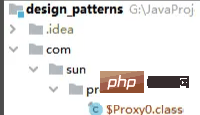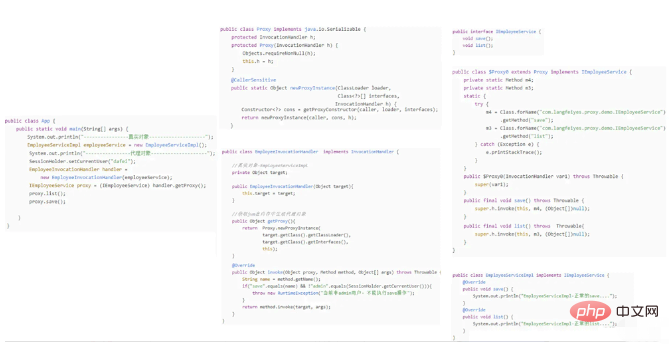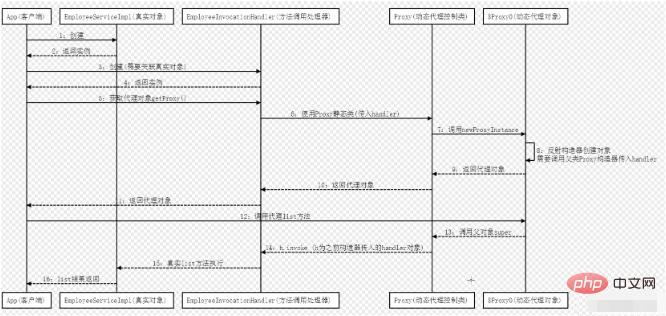How to implement JDK dynamic proxy in Java
Concept
Agent: In order to control the A object, a new B object is created, and the B object performs all operations of the A object instead, which is called an agent. The establishment of an agency system involves three participating roles: the real object (A), the proxy object (B), and the client.
The proxy object (B) plays an intermediary role, connecting the real object (A) and the client. If further expanded, the proxy object can implement more complex logic, such as access control for the real object.
Case
Requirements: The employee business layer interface requires admin permission to call save, and calling list does not require permission. An exception will be thrown when calling without permission.
Static proxy
/**
* 代理接口
*/
public interface IEmployeeService {
void save();
void list();
}/**
* 真实对象
*/
public class EmployeeServiceImpl implements IEmployeeService {
@Override
public void save() {
System.out.println("EmployeeServiceImpl-正常的save....");
}
@Override
public void list() {
System.out.println("EmployeeServiceImpl-正常的list....");
}
}/**
* 模拟当前登录用户对象
*/
public class SessionHolder {
private static String currentUser;
public static String getCurrentUser(){
return currentUser;
}
public static void setCurrentUser(String currentUser){
SessionHolder.currentUser = currentUser;
}
}/**
* 代理对象
*/
public class EmployeeProxy implements IEmployeeService {
//真实对象
private EmployeeServiceImpl employeeService;
public EmployeeProxy(EmployeeServiceImpl employeeService){
this.employeeService = employeeService;
}
@Override
public void save() {
//权限判断
if("admin".equals(SessionHolder.getCurrentUser())){
employeeService.save();
}else{
throw new RuntimeException("当前非admin用户,不能执行save操作");
}
}
@Override
public void list() {
employeeService.list();
}
}public class App {
public static void main(String[] args) {
System.out.println("----------------真实对象--------------------");
EmployeeServiceImpl employeeService = new EmployeeServiceImpl();
employeeService.list();
employeeService.save();
System.out.println("----------------代理对象--------------------");
SessionHolder.setCurrentUser("dafei"); //设置权限(当前登录用户)
EmployeeProxy employeeProxy = new EmployeeProxy(employeeService);
employeeProxy.list();
employeeProxy.save();
}
}----------------真实对象-------------------- EmployeeServiceImpl-正常的list.... EmployeeServiceImpl-正常的save.... ----------------代理对象-------------------- EmployeeServiceImpl-正常的list.... Exception in thread "main" java.lang.RuntimeException: 当前非admin用户,不能执行save操作 at com.langfeiyes.pattern.proxy.demo.EmployeeProxy.save(EmployeeProxy.java:20) at com.langfeiyes.pattern.proxy.demo.App.main(App.java:16)
When calling directly using the real object EmployeeServiceImpl, both list and save can be accessed directly, but it does not meet the admin permission restrictions on the requirements. If you use the proxy object EmployeeProxy, you can complete the requirements.
Complete the proxy logic by directly creating a new class of proxy objects. This method is called the static proxy mode.
JDK dynamic proxy mode
The commonly used dynamic proxy modes in Java include JDK dynamic proxy and cglib dynamic proxy. Here we focus on JDK dynamic proxy
Still the original demand , the previous IEmployeeService EmployeeServiceImpl SessionHolder has not changed, a new JDK proxy controller-EmployeeInvocationHandler
/**
* jdk动态代理控制类,由它牵头代理类获取,代理方法的执行
*/
public class EmployeeInvocationHandler implements InvocationHandler {
//真实对象-EmployeeServiceImpl
private Object target;
public EmployeeInvocationHandler(Object target){
this.target = target;
}
//获取jvm在内存中生成代理对象
public Object getProxy(){
return Proxy.newProxyInstance(
target.getClass().getClassLoader(),
target.getClass().getInterfaces(),
this);
}
//代理对象控制执行方法
//参数1:代理对象
//参数2:真实对象的方法(使用方式得到方法对象)
//参数3:真实对象方法参数列表
//此处是代理对象对外暴露的可编辑的方法处理场所,代理对象每调用一个次方法,就会执行一次invoke
@Override
public Object invoke(Object proxy, Method method, Object[] args) throws Throwable {
String name = method.getName();
if("save".equals(name) && !"admin".equals(SessionHolder.getCurrentUser())){
throw new RuntimeException("当前非admin用户,不能执行save操作");
}
return method.invoke(target, args);
}
}The test App class is slightly changed:
public class App {
public static void main(String[] args) {
System.out.println("----------------真实对象--------------------");
EmployeeServiceImpl employeeService = new EmployeeServiceImpl();
employeeService.list();
employeeService.save();
System.out.println("----------------代理对象--------------------");
SessionHolder.setCurrentUser("dafei");
EmployeeInvocationHandler handler =
new EmployeeInvocationHandler(employeeService);
IEmployeeService proxy = (IEmployeeService) handler.getProxy();
proxy.list();
proxy.save();
}
}The above code can be the same The difference between implementing requirements and static proxy is that less proxy objects are created. There is a question at this point. No proxy object is created. Why can the proxy class call be implemented? ?
Principle Analysis
Let’s first conclude with the underlying implementation principle of JDK dynamic proxy: using interface implementation, at runtime, a class is dynamically constructed in memory, and then compiled and executed. This class is one-time use. When the JVM is stopped, the proxy class disappears.
Participating roles To understand the principle of JDK dynamic proxy, you must first understand the classes involved in JDK dynamic proxy

InvocationHandler : Real object method invocation processor, built-in invoke method, its function: customize proxy logic for the real object
EmployeeInvocationHandler: Employee service real object method invocation processor, this type has 3 uses: 1>Set the real object
//真实对象-EmployeeServiceImpl
private Object target;
public EmployeeInvocationHandler(Object target){
this.target = target;
}2>Customize the proxy method implementation logic
Added permission verification logic for the real object save method
//代理对象控制执行方法
//参数1:代理对象
//参数2:真实对象的方法(使用方式得到方法对象)
//参数3:真实对象方法参数列表
//此处是代理对象对外暴露的可编辑的方法处理场所,代理对象每调用一个次方法,就会执行一次invoke
@Override
public Object invoke(Object proxy, Method method, Object[] args) throws Throwable {
String name = method.getName();
if("save".equals(name) && !"admin".equals(SessionHolder.getCurrentUser())){
throw new RuntimeException("当前非admin用户,不能执行save操作");
}
return method.invoke(target, args);
}3>Return After the proxy object
method is executed, a proxy class named: $ProxyX (where X is the serial number, generally defaults to 0) is returned. This proxy class is dynamically constructed by the JDK.
//获取jvm在内存中生成代理对象
public Object getProxy(){
return Proxy.newProxyInstance(
target.getClass().getClassLoader(),
target.getClass().getInterfaces(),
this);
}Proxy: Dynamic proxy control class is the parent class of the $ProxyX class dynamically generated by JDK. Its functions are as follows:
1> Build a proxy object by calling the ProxyBuilder class builder method Class
private static Constructor<?> getProxyConstructor(Class<?> caller,
ClassLoader loader,
Class<?>... interfaces){
return proxyCache.sub(intf).computeIfAbsent(
loader,
(ld, clv) -> new ProxyBuilder(ld, clv.key()).build()
);
}2> Return an instance of the $ProxyX class through the newProxyInstance method
public static Object newProxyInstance(ClassLoader loader,
Class<?>[] interfaces,
InvocationHandler h) {
//...
}$Proxy0: When the App class is running, the proxy class dynamically built by the JDK is inherited to Proxy class
public class App {
public static void main(String[] args) {
//System.setProperty("sun.misc.ProxyGenerator.saveGeneratedFiles", "true");
System.setProperty("jdk.proxy.ProxyGenerator.saveGeneratedFiles", "true");
System.out.println("----------------真实对象--------------------");
EmployeeServiceImpl employeeService = new EmployeeServiceImpl();
employeeService.list();
employeeService.save();
System.out.println("----------------代理对象--------------------");
SessionHolder.setCurrentUser("dafei");
EmployeeInvocationHandler handler =
new EmployeeInvocationHandler(employeeService);
IEmployeeService proxy = (IEmployeeService) handler.getProxy();
proxy.list();
proxy.save();
}
}By default, the JVM does not save dynamically created proxy class bytecode objects. You can configure the proxy parameters in the main method to retain the bytecode
//JDK8之前
System.setProperty("sun.misc.ProxyGenerator.saveGeneratedFiles", "true");
//JDK8之后
System.setProperty("jdk.proxy.ProxyGenerator.saveGeneratedFiles", "true");After execution, A proxy class bytecode object will be generated in the project root directory.

In order to facilitate interpretation, after removing some unnecessary methods
$Proxy0 class
public class $Proxy0 extends Proxy implements IEmployeeService {
private static Method m4;
private static Method m3;
static {
try {
m4 = Class.forName("com.langfeiyes.proxy.demo.IEmployeeService")
.getMethod("save");
m3 = Class.forName("com.langfeiyes.proxy.demo.IEmployeeService")
.getMethod("list");
} catch (Exception e) {
e.printStackTrace();
}
}
public $Proxy0(InvocationHandler var1) throws Throwable {
super(var1);
}
public final void save() throws Throwable {
super.h.invoke(this, m4, (Object[])null);
}
public final void list() throws Throwable{
super.h.invoke(this, m3, (Object[])null);
}
}Looking from the source code, the characteristics of $Proxy0 are:
1>Inherits the Proxy class and implements the IEmployeeService interface
2> Reflect the save and list methods of the IEmployeeService interface through static blocks to obtain their method objects Method
3> To call the parent class constructor, you need to pass in the InvocationHandler parameter
4> Rewriting the save list method of the IEmployeeService interface relies on the h attribute.invoke method of the parent class Proxy
The truth is revealed
The following picture shows all the classes participating in dynamic proxy:

The following picture is the operation sequence diagram of the above picture, just follow it

The above is the detailed content of How to implement JDK dynamic proxy in Java. For more information, please follow other related articles on the PHP Chinese website!

Hot AI Tools

Undresser.AI Undress
AI-powered app for creating realistic nude photos

AI Clothes Remover
Online AI tool for removing clothes from photos.

Undress AI Tool
Undress images for free

Clothoff.io
AI clothes remover

Video Face Swap
Swap faces in any video effortlessly with our completely free AI face swap tool!

Hot Article

Hot Tools

Notepad++7.3.1
Easy-to-use and free code editor

SublimeText3 Chinese version
Chinese version, very easy to use

Zend Studio 13.0.1
Powerful PHP integrated development environment

Dreamweaver CS6
Visual web development tools

SublimeText3 Mac version
God-level code editing software (SublimeText3)

Hot Topics
 1386
1386
 52
52
 Perfect Number in Java
Aug 30, 2024 pm 04:28 PM
Perfect Number in Java
Aug 30, 2024 pm 04:28 PM
Guide to Perfect Number in Java. Here we discuss the Definition, How to check Perfect number in Java?, examples with code implementation.
 Weka in Java
Aug 30, 2024 pm 04:28 PM
Weka in Java
Aug 30, 2024 pm 04:28 PM
Guide to Weka in Java. Here we discuss the Introduction, how to use weka java, the type of platform, and advantages with examples.
 Smith Number in Java
Aug 30, 2024 pm 04:28 PM
Smith Number in Java
Aug 30, 2024 pm 04:28 PM
Guide to Smith Number in Java. Here we discuss the Definition, How to check smith number in Java? example with code implementation.
 Java Spring Interview Questions
Aug 30, 2024 pm 04:29 PM
Java Spring Interview Questions
Aug 30, 2024 pm 04:29 PM
In this article, we have kept the most asked Java Spring Interview Questions with their detailed answers. So that you can crack the interview.
 Break or return from Java 8 stream forEach?
Feb 07, 2025 pm 12:09 PM
Break or return from Java 8 stream forEach?
Feb 07, 2025 pm 12:09 PM
Java 8 introduces the Stream API, providing a powerful and expressive way to process data collections. However, a common question when using Stream is: How to break or return from a forEach operation? Traditional loops allow for early interruption or return, but Stream's forEach method does not directly support this method. This article will explain the reasons and explore alternative methods for implementing premature termination in Stream processing systems. Further reading: Java Stream API improvements Understand Stream forEach The forEach method is a terminal operation that performs one operation on each element in the Stream. Its design intention is
 TimeStamp to Date in Java
Aug 30, 2024 pm 04:28 PM
TimeStamp to Date in Java
Aug 30, 2024 pm 04:28 PM
Guide to TimeStamp to Date in Java. Here we also discuss the introduction and how to convert timestamp to date in java along with examples.
 Java Program to Find the Volume of Capsule
Feb 07, 2025 am 11:37 AM
Java Program to Find the Volume of Capsule
Feb 07, 2025 am 11:37 AM
Capsules are three-dimensional geometric figures, composed of a cylinder and a hemisphere at both ends. The volume of the capsule can be calculated by adding the volume of the cylinder and the volume of the hemisphere at both ends. This tutorial will discuss how to calculate the volume of a given capsule in Java using different methods. Capsule volume formula The formula for capsule volume is as follows: Capsule volume = Cylindrical volume Volume Two hemisphere volume in, r: The radius of the hemisphere. h: The height of the cylinder (excluding the hemisphere). Example 1 enter Radius = 5 units Height = 10 units Output Volume = 1570.8 cubic units explain Calculate volume using formula: Volume = π × r2 × h (4
 Create the Future: Java Programming for Absolute Beginners
Oct 13, 2024 pm 01:32 PM
Create the Future: Java Programming for Absolute Beginners
Oct 13, 2024 pm 01:32 PM
Java is a popular programming language that can be learned by both beginners and experienced developers. This tutorial starts with basic concepts and progresses through advanced topics. After installing the Java Development Kit, you can practice programming by creating a simple "Hello, World!" program. After you understand the code, use the command prompt to compile and run the program, and "Hello, World!" will be output on the console. Learning Java starts your programming journey, and as your mastery deepens, you can create more complex applications.




